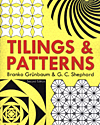- About MAA
- Membership
- MAA Publications
- Periodicals
- Blogs
- MAA Book Series
- MAA Press (an imprint of the AMS)
- MAA Notes
- MAA Reviews
- Mathematical Communication
- Information for Libraries
- Author Resources
- Advertise with MAA
- Meetings
- Competitions
- Programs
- Communities
- MAA Sections
- SIGMAA
- MAA Connect
- Students
- MAA Awards
- Awards Booklets
- Writing Awards
- Teaching Awards
- Service Awards
- Research Awards
- Lecture Awards
- Putnam Competition Individual and Team Winners
- D. E. Shaw Group AMC 8 Awards & Certificates
- Maryam Mirzakhani AMC 10 A Awards & Certificates
- Two Sigma AMC 10 B Awards & Certificates
- Jane Street AMC 12 A Awards & Certificates
- Akamai AMC 12 B Awards & Certificates
- High School Teachers
- News
You are here
Tilings and Patterns

Publisher:
Dover Publications
Publication Date:
2016
Number of Pages:
720
Format:
Paperback
Edition:
2
Price:
44.95
ISBN:
9780486469812
Category:
Monograph
The Basic Library List Committee considers this book essential for undergraduate mathematics libraries.
[Reviewed by , on ]
William J. Satzer
11/29/2016
Tilings and Patterns, first published in 1987, has recently been re-published by Dover. Although it got outstanding reviews following its appearance, the original publisher chose to discontinue it in 1998. Dover has once again done the mathematical community a service in bringing back such a notable volume.
The authors have left the original unchanged in most respects. Besides correcting minor typographical errors, the authors have added an appendix with references to new material that has appeared in the literature over the intervening decades. Of course, this does not make the book completely up to date. (For instance, some more recently discovered convex pentagonal tilings are not mentioned.) It would be a truly mind-boggling task to update the book completely considering how much is here already.
According to their preface the authors began with the idea of writing a rigorous book on “visual geometry” that would encourage a renewed appreciation of geometry and the use of purely geometrical reasoning. Eventually they decided to focus on tilings and patterns. They envisioned three distinct groups of readers: students, professional mathematicians and a variety of non-mathematicians (artists, architects, crystallographers, and the like.) Their idea was that the book should be accessible to any reader who is attracted to geometry.
The first part of the book focuses on the basic geometry of planar tilings and patterns. A plane tiling is defined broadly as a countable family of closed sets that cover the plane without gaps or overlaps. However, the authors mostly restrict themselves to a class of well-behaved tilings that have conditions designed to eliminate undesirable and pathological examples. Patterns, which can also be defined very broadly, are mostly treated here as repetitions of a motif in the plane in a regular manner with certain natural technical restrictions.
The book starts with an introduction that presents a survey of tilings and patterns from a variety of cultures and historical periods. Other highlights of the first part of the book are an extensive treatment of tilings by regular polygons and star-shaped polygons, topological equivalence of tilings by homeomorphism, and classifications of tilings according to symmetries and transitivity properties. The authors suggest that the first seven chapters of the book could be used for an undergraduate geometry course.
The second part of the book looks at a few advanced topics. Colored tilings are described at some length. Although colored tilings have been far and away the most commonly used tilings in the decorative arts, almost no systematic work on them had been done before the current book. (Unfortunately, all the figures in the book are in grayscale). Aperiodic tilings are also treated extensively. Prominent examples include variations due to Penrose and Wang. Wang tilings get special attention because it is possible to find sets of Wang tiles that can be used to mimic the behavior of any Turing machine, and hence they are relevant to questions of mathematical logic.
The most striking feature of the book is its extensive collection of figures, including hundreds of examples of tilings and patterns. The sheer abundance is perhaps one reason why artists and designers have been drawn to it over the years. While portions of the book are accessible to those with limited mathematical backgrounds, a basic knowledge of topology and algebra (and sometime more) is needed to follow the details of the development. Nonetheless, this is a book that almost anyone would enjoy dipping into.
Bill Satzer (bsatzer@gmail.com) was a senior intellectual property scientist at 3M Company. His training is in dynamical systems and particularly celestial mechanics; his current interests are broadly in applied mathematics and the teaching of mathematics.
The table of contents is not available.
- Log in to post comments




